Relationship between Logistics and Supply Chain Management: A Case Study of Sainsbury
VerifiedAdded on 2023/06/10
|11
|2646
|104
AI Summary
This report analyzes the relationship between logistics management and supply chain management. It also discusses how effective logistics management can improve the profitability of Sainsbury Company. The report raises the discussion regarding practices used to increase company’s reliability in the logistics and supply chain management.
Contribute Materials
Your contribution can guide someone’s learning journey. Share your
documents today.
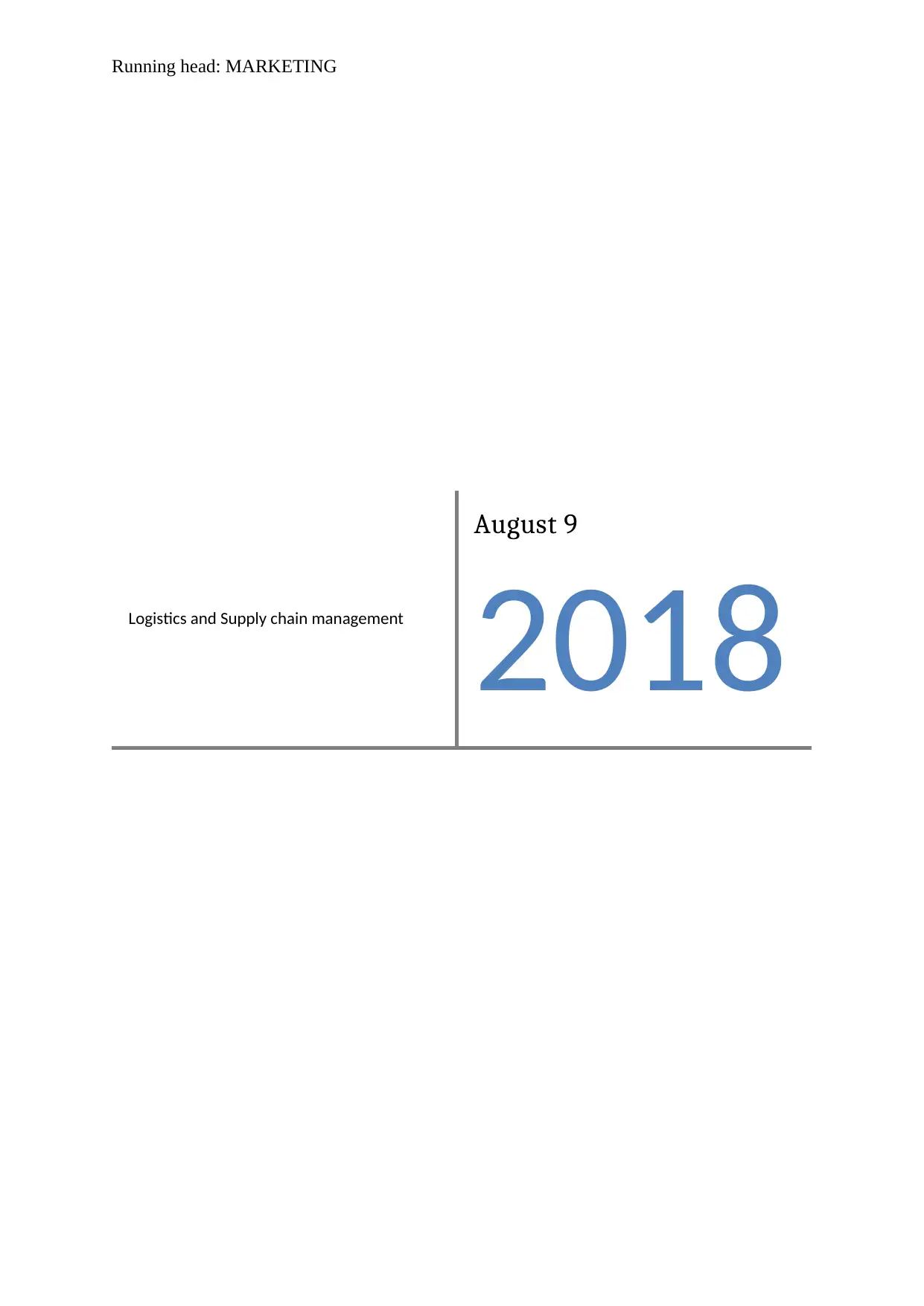
Running head: MARKETING
Logistics and Supply chain management
August 9
2018
Logistics and Supply chain management
August 9
2018
Secure Best Marks with AI Grader
Need help grading? Try our AI Grader for instant feedback on your assignments.
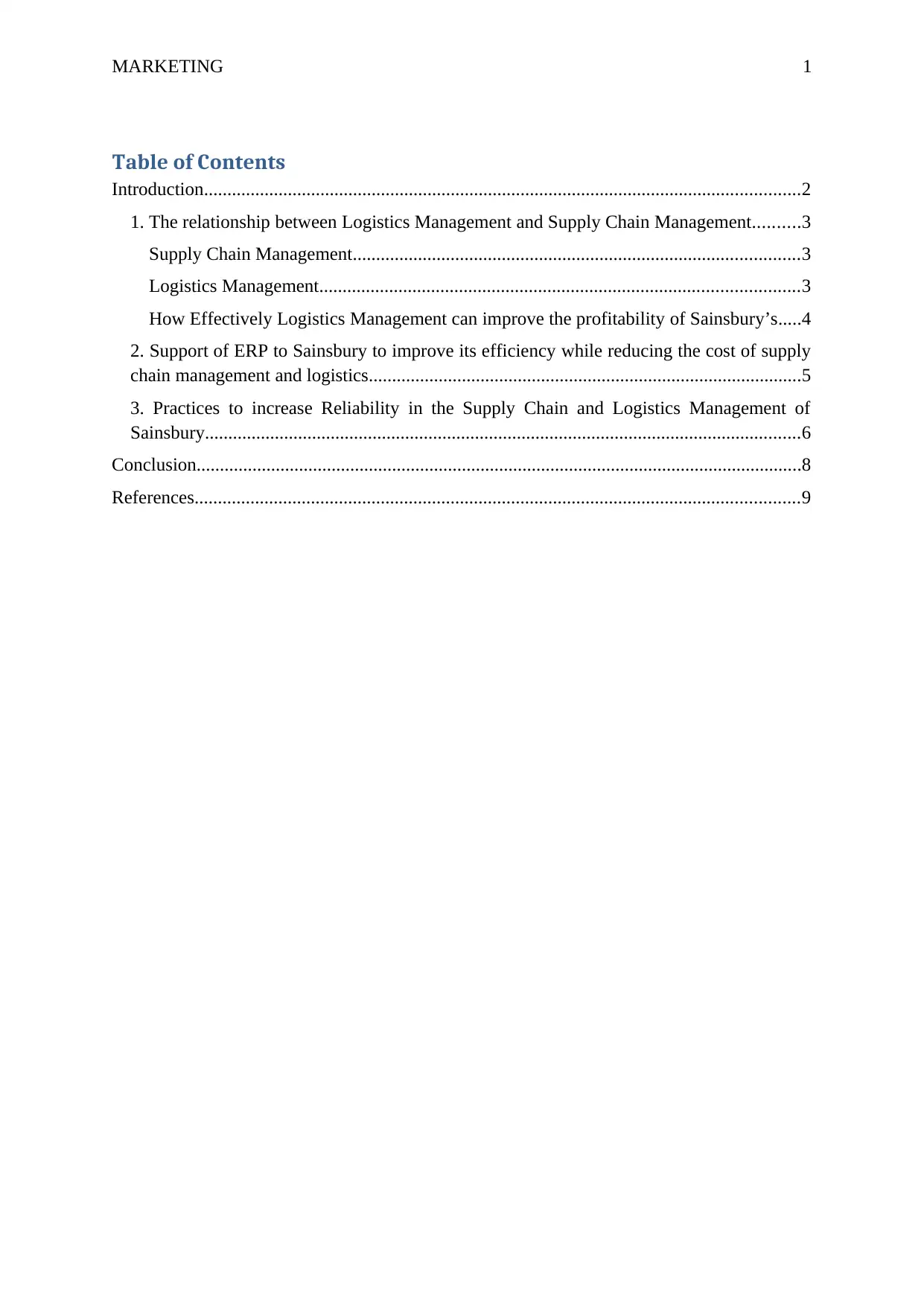
MARKETING 1
Table of Contents
Introduction................................................................................................................................2
1. The relationship between Logistics Management and Supply Chain Management..........3
Supply Chain Management................................................................................................3
Logistics Management.......................................................................................................3
How Effectively Logistics Management can improve the profitability of Sainsbury’s.....4
2. Support of ERP to Sainsbury to improve its efficiency while reducing the cost of supply
chain management and logistics.............................................................................................5
3. Practices to increase Reliability in the Supply Chain and Logistics Management of
Sainsbury................................................................................................................................6
Conclusion..................................................................................................................................8
References..................................................................................................................................9
Table of Contents
Introduction................................................................................................................................2
1. The relationship between Logistics Management and Supply Chain Management..........3
Supply Chain Management................................................................................................3
Logistics Management.......................................................................................................3
How Effectively Logistics Management can improve the profitability of Sainsbury’s.....4
2. Support of ERP to Sainsbury to improve its efficiency while reducing the cost of supply
chain management and logistics.............................................................................................5
3. Practices to increase Reliability in the Supply Chain and Logistics Management of
Sainsbury................................................................................................................................6
Conclusion..................................................................................................................................8
References..................................................................................................................................9
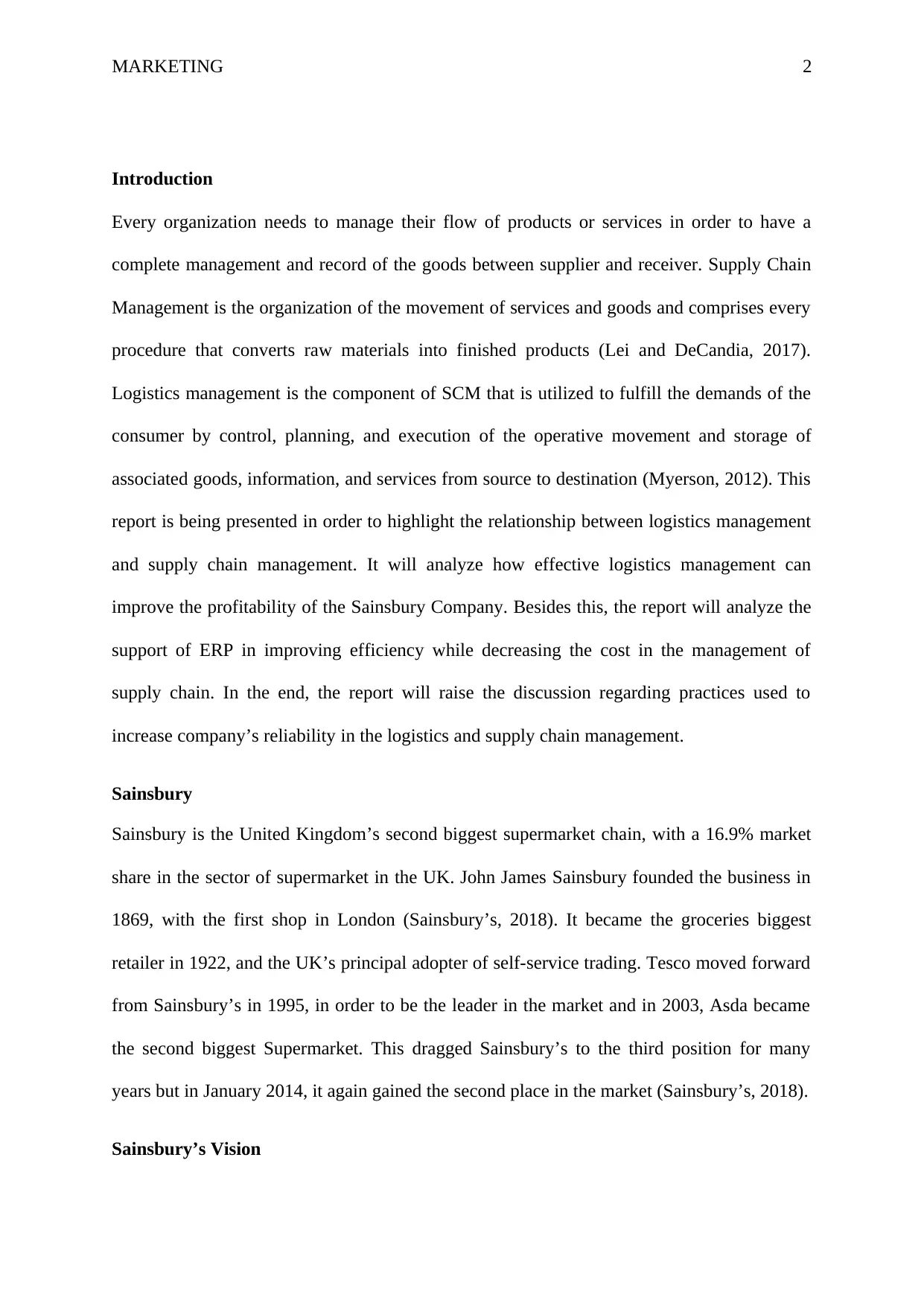
MARKETING 2
Introduction
Every organization needs to manage their flow of products or services in order to have a
complete management and record of the goods between supplier and receiver. Supply Chain
Management is the organization of the movement of services and goods and comprises every
procedure that converts raw materials into finished products (Lei and DeCandia, 2017).
Logistics management is the component of SCM that is utilized to fulfill the demands of the
consumer by control, planning, and execution of the operative movement and storage of
associated goods, information, and services from source to destination (Myerson, 2012). This
report is being presented in order to highlight the relationship between logistics management
and supply chain management. It will analyze how effective logistics management can
improve the profitability of the Sainsbury Company. Besides this, the report will analyze the
support of ERP in improving efficiency while decreasing the cost in the management of
supply chain. In the end, the report will raise the discussion regarding practices used to
increase company’s reliability in the logistics and supply chain management.
Sainsbury
Sainsbury is the United Kingdom’s second biggest supermarket chain, with a 16.9% market
share in the sector of supermarket in the UK. John James Sainsbury founded the business in
1869, with the first shop in London (Sainsbury’s, 2018). It became the groceries biggest
retailer in 1922, and the UK’s principal adopter of self-service trading. Tesco moved forward
from Sainsbury’s in 1995, in order to be the leader in the market and in 2003, Asda became
the second biggest Supermarket. This dragged Sainsbury’s to the third position for many
years but in January 2014, it again gained the second place in the market (Sainsbury’s, 2018).
Sainsbury’s Vision
Introduction
Every organization needs to manage their flow of products or services in order to have a
complete management and record of the goods between supplier and receiver. Supply Chain
Management is the organization of the movement of services and goods and comprises every
procedure that converts raw materials into finished products (Lei and DeCandia, 2017).
Logistics management is the component of SCM that is utilized to fulfill the demands of the
consumer by control, planning, and execution of the operative movement and storage of
associated goods, information, and services from source to destination (Myerson, 2012). This
report is being presented in order to highlight the relationship between logistics management
and supply chain management. It will analyze how effective logistics management can
improve the profitability of the Sainsbury Company. Besides this, the report will analyze the
support of ERP in improving efficiency while decreasing the cost in the management of
supply chain. In the end, the report will raise the discussion regarding practices used to
increase company’s reliability in the logistics and supply chain management.
Sainsbury
Sainsbury is the United Kingdom’s second biggest supermarket chain, with a 16.9% market
share in the sector of supermarket in the UK. John James Sainsbury founded the business in
1869, with the first shop in London (Sainsbury’s, 2018). It became the groceries biggest
retailer in 1922, and the UK’s principal adopter of self-service trading. Tesco moved forward
from Sainsbury’s in 1995, in order to be the leader in the market and in 2003, Asda became
the second biggest Supermarket. This dragged Sainsbury’s to the third position for many
years but in January 2014, it again gained the second place in the market (Sainsbury’s, 2018).
Sainsbury’s Vision
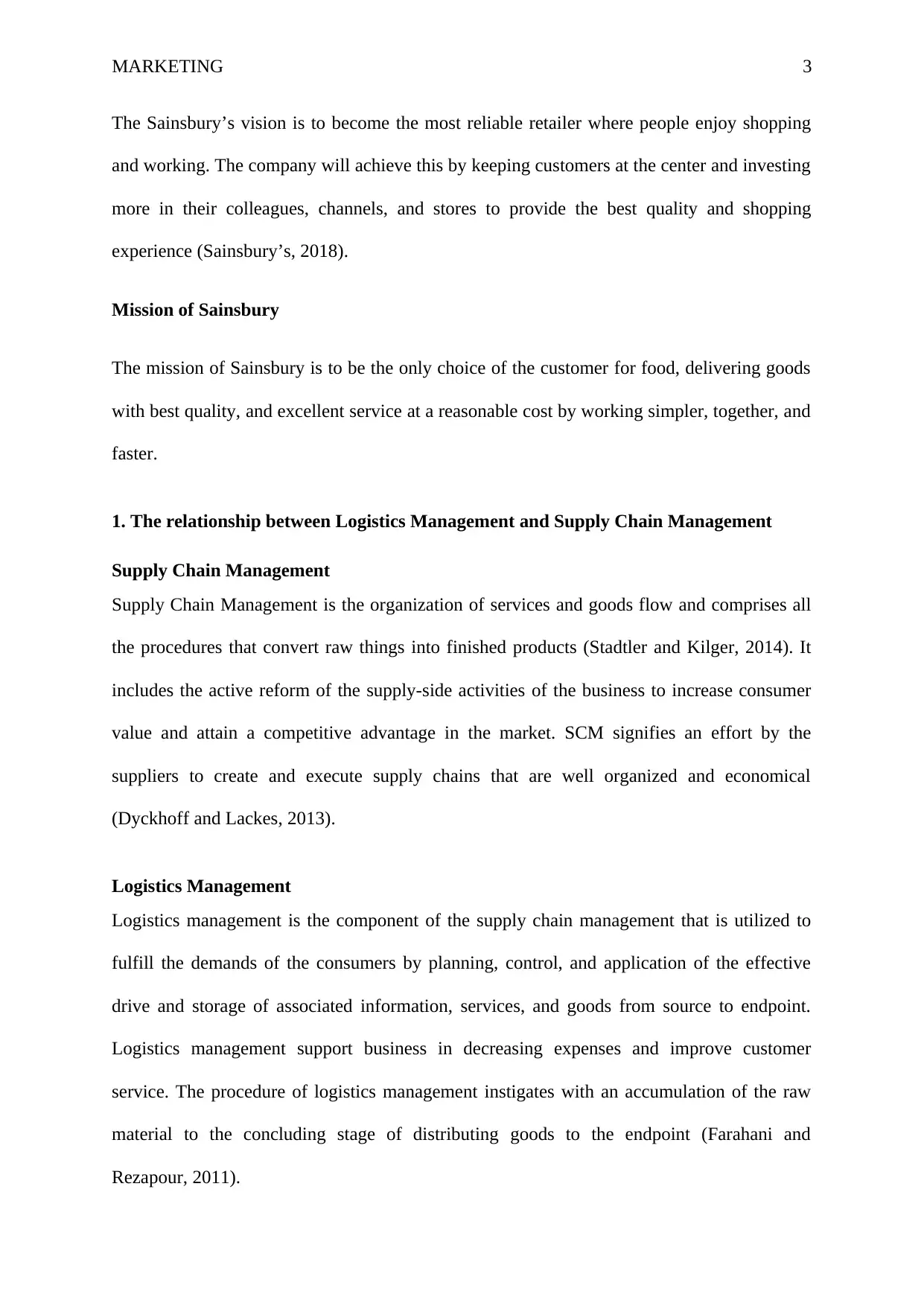
MARKETING 3
The Sainsbury’s vision is to become the most reliable retailer where people enjoy shopping
and working. The company will achieve this by keeping customers at the center and investing
more in their colleagues, channels, and stores to provide the best quality and shopping
experience (Sainsbury’s, 2018).
Mission of Sainsbury
The mission of Sainsbury is to be the only choice of the customer for food, delivering goods
with best quality, and excellent service at a reasonable cost by working simpler, together, and
faster.
1. The relationship between Logistics Management and Supply Chain Management
Supply Chain Management
Supply Chain Management is the organization of services and goods flow and comprises all
the procedures that convert raw things into finished products (Stadtler and Kilger, 2014). It
includes the active reform of the supply-side activities of the business to increase consumer
value and attain a competitive advantage in the market. SCM signifies an effort by the
suppliers to create and execute supply chains that are well organized and economical
(Dyckhoff and Lackes, 2013).
Logistics Management
Logistics management is the component of the supply chain management that is utilized to
fulfill the demands of the consumers by planning, control, and application of the effective
drive and storage of associated information, services, and goods from source to endpoint.
Logistics management support business in decreasing expenses and improve customer
service. The procedure of logistics management instigates with an accumulation of the raw
material to the concluding stage of distributing goods to the endpoint (Farahani and
Rezapour, 2011).
The Sainsbury’s vision is to become the most reliable retailer where people enjoy shopping
and working. The company will achieve this by keeping customers at the center and investing
more in their colleagues, channels, and stores to provide the best quality and shopping
experience (Sainsbury’s, 2018).
Mission of Sainsbury
The mission of Sainsbury is to be the only choice of the customer for food, delivering goods
with best quality, and excellent service at a reasonable cost by working simpler, together, and
faster.
1. The relationship between Logistics Management and Supply Chain Management
Supply Chain Management
Supply Chain Management is the organization of services and goods flow and comprises all
the procedures that convert raw things into finished products (Stadtler and Kilger, 2014). It
includes the active reform of the supply-side activities of the business to increase consumer
value and attain a competitive advantage in the market. SCM signifies an effort by the
suppliers to create and execute supply chains that are well organized and economical
(Dyckhoff and Lackes, 2013).
Logistics Management
Logistics management is the component of the supply chain management that is utilized to
fulfill the demands of the consumers by planning, control, and application of the effective
drive and storage of associated information, services, and goods from source to endpoint.
Logistics management support business in decreasing expenses and improve customer
service. The procedure of logistics management instigates with an accumulation of the raw
material to the concluding stage of distributing goods to the endpoint (Farahani and
Rezapour, 2011).
Secure Best Marks with AI Grader
Need help grading? Try our AI Grader for instant feedback on your assignments.
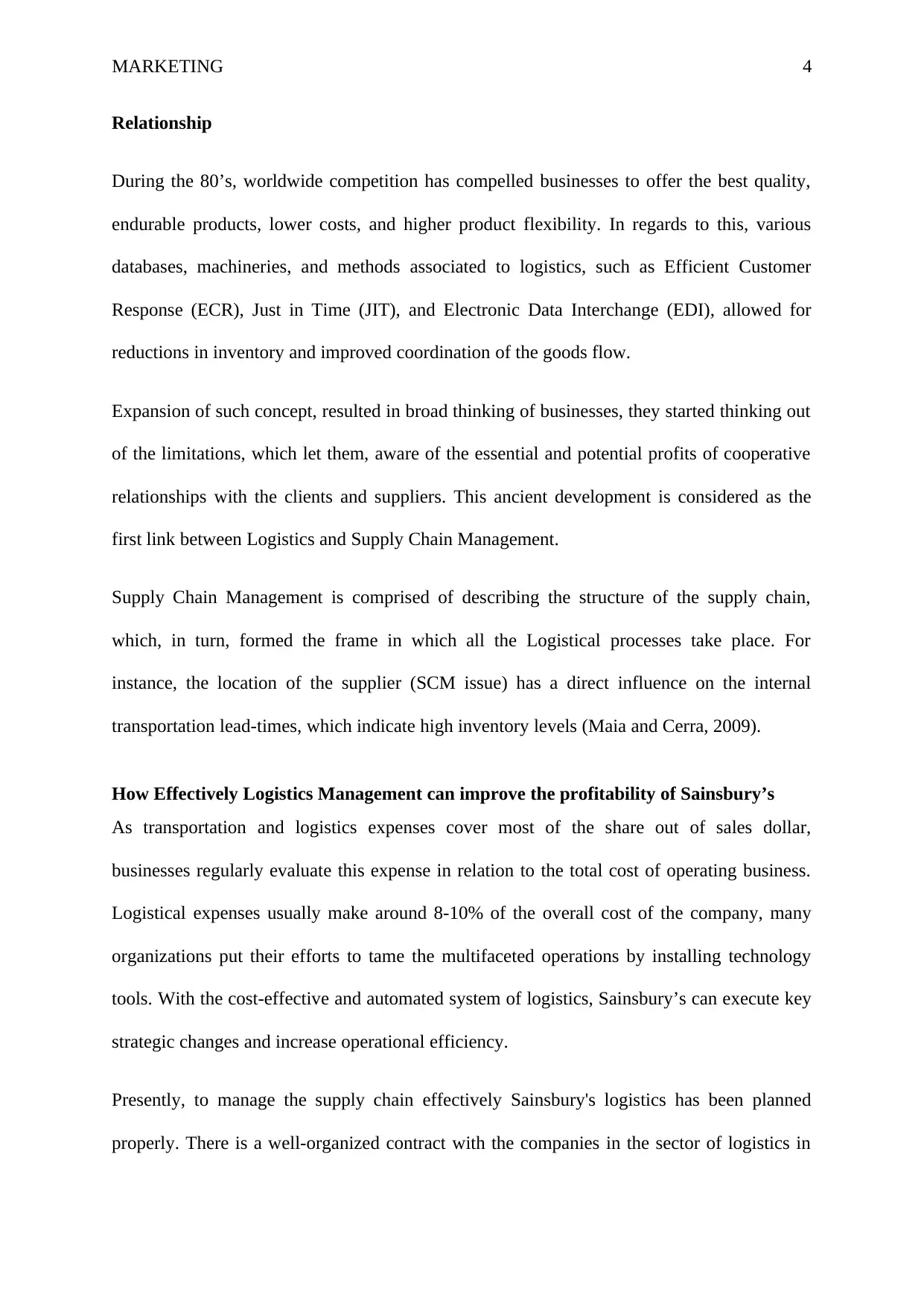
MARKETING 4
Relationship
During the 80’s, worldwide competition has compelled businesses to offer the best quality,
endurable products, lower costs, and higher product flexibility. In regards to this, various
databases, machineries, and methods associated to logistics, such as Efficient Customer
Response (ECR), Just in Time (JIT), and Electronic Data Interchange (EDI), allowed for
reductions in inventory and improved coordination of the goods flow.
Expansion of such concept, resulted in broad thinking of businesses, they started thinking out
of the limitations, which let them, aware of the essential and potential profits of cooperative
relationships with the clients and suppliers. This ancient development is considered as the
first link between Logistics and Supply Chain Management.
Supply Chain Management is comprised of describing the structure of the supply chain,
which, in turn, formed the frame in which all the Logistical processes take place. For
instance, the location of the supplier (SCM issue) has a direct influence on the internal
transportation lead-times, which indicate high inventory levels (Maia and Cerra, 2009).
How Effectively Logistics Management can improve the profitability of Sainsbury’s
As transportation and logistics expenses cover most of the share out of sales dollar,
businesses regularly evaluate this expense in relation to the total cost of operating business.
Logistical expenses usually make around 8-10% of the overall cost of the company, many
organizations put their efforts to tame the multifaceted operations by installing technology
tools. With the cost-effective and automated system of logistics, Sainsbury’s can execute key
strategic changes and increase operational efficiency.
Presently, to manage the supply chain effectively Sainsbury's logistics has been planned
properly. There is a well-organized contract with the companies in the sector of logistics in
Relationship
During the 80’s, worldwide competition has compelled businesses to offer the best quality,
endurable products, lower costs, and higher product flexibility. In regards to this, various
databases, machineries, and methods associated to logistics, such as Efficient Customer
Response (ECR), Just in Time (JIT), and Electronic Data Interchange (EDI), allowed for
reductions in inventory and improved coordination of the goods flow.
Expansion of such concept, resulted in broad thinking of businesses, they started thinking out
of the limitations, which let them, aware of the essential and potential profits of cooperative
relationships with the clients and suppliers. This ancient development is considered as the
first link between Logistics and Supply Chain Management.
Supply Chain Management is comprised of describing the structure of the supply chain,
which, in turn, formed the frame in which all the Logistical processes take place. For
instance, the location of the supplier (SCM issue) has a direct influence on the internal
transportation lead-times, which indicate high inventory levels (Maia and Cerra, 2009).
How Effectively Logistics Management can improve the profitability of Sainsbury’s
As transportation and logistics expenses cover most of the share out of sales dollar,
businesses regularly evaluate this expense in relation to the total cost of operating business.
Logistical expenses usually make around 8-10% of the overall cost of the company, many
organizations put their efforts to tame the multifaceted operations by installing technology
tools. With the cost-effective and automated system of logistics, Sainsbury’s can execute key
strategic changes and increase operational efficiency.
Presently, to manage the supply chain effectively Sainsbury's logistics has been planned
properly. There is a well-organized contract with the companies in the sector of logistics in
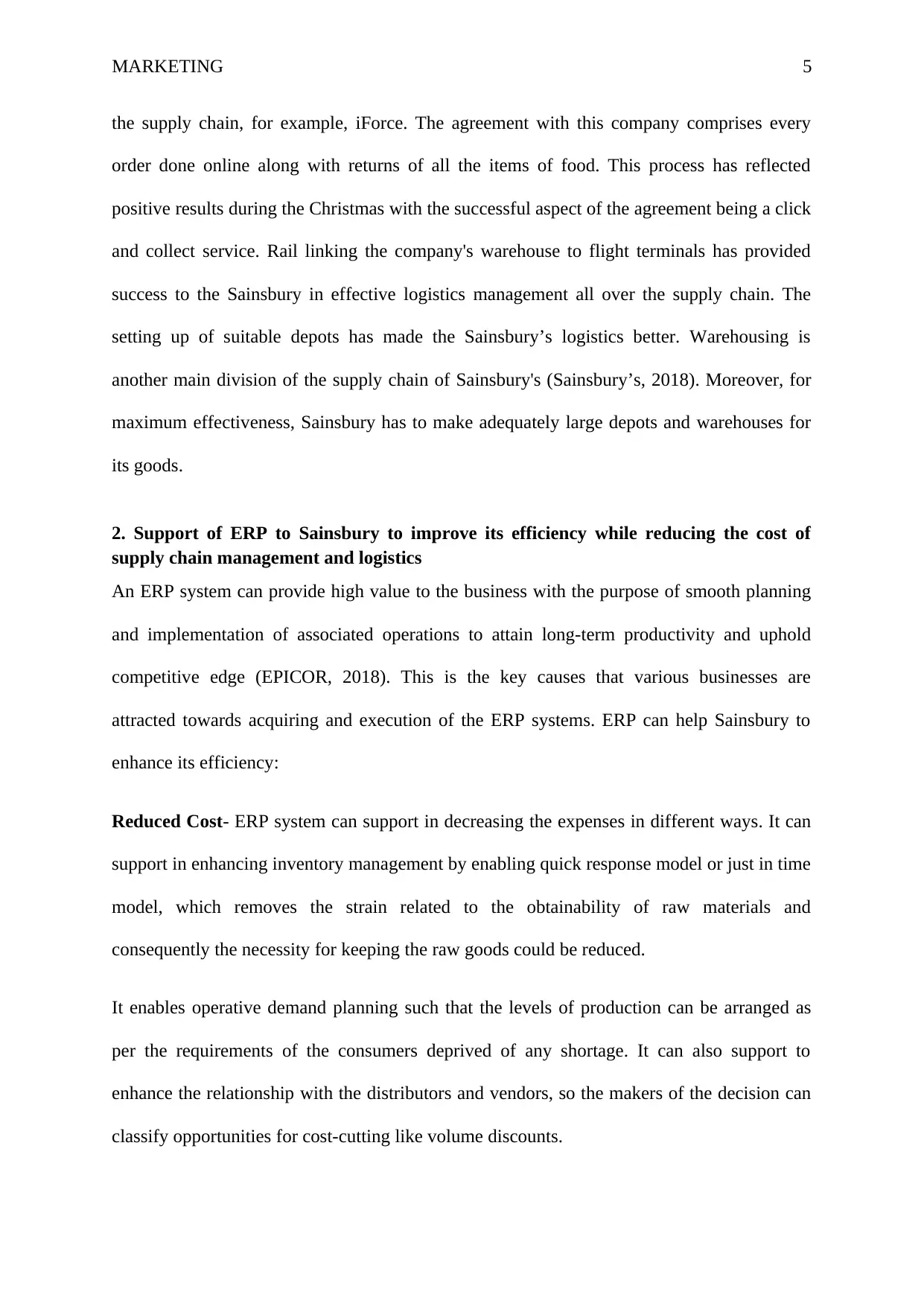
MARKETING 5
the supply chain, for example, iForce. The agreement with this company comprises every
order done online along with returns of all the items of food. This process has reflected
positive results during the Christmas with the successful aspect of the agreement being a click
and collect service. Rail linking the company's warehouse to flight terminals has provided
success to the Sainsbury in effective logistics management all over the supply chain. The
setting up of suitable depots has made the Sainsbury’s logistics better. Warehousing is
another main division of the supply chain of Sainsbury's (Sainsbury’s, 2018). Moreover, for
maximum effectiveness, Sainsbury has to make adequately large depots and warehouses for
its goods.
2. Support of ERP to Sainsbury to improve its efficiency while reducing the cost of
supply chain management and logistics
An ERP system can provide high value to the business with the purpose of smooth planning
and implementation of associated operations to attain long-term productivity and uphold
competitive edge (EPICOR, 2018). This is the key causes that various businesses are
attracted towards acquiring and execution of the ERP systems. ERP can help Sainsbury to
enhance its efficiency:
Reduced Cost- ERP system can support in decreasing the expenses in different ways. It can
support in enhancing inventory management by enabling quick response model or just in time
model, which removes the strain related to the obtainability of raw materials and
consequently the necessity for keeping the raw goods could be reduced.
It enables operative demand planning such that the levels of production can be arranged as
per the requirements of the consumers deprived of any shortage. It can also support to
enhance the relationship with the distributors and vendors, so the makers of the decision can
classify opportunities for cost-cutting like volume discounts.
the supply chain, for example, iForce. The agreement with this company comprises every
order done online along with returns of all the items of food. This process has reflected
positive results during the Christmas with the successful aspect of the agreement being a click
and collect service. Rail linking the company's warehouse to flight terminals has provided
success to the Sainsbury in effective logistics management all over the supply chain. The
setting up of suitable depots has made the Sainsbury’s logistics better. Warehousing is
another main division of the supply chain of Sainsbury's (Sainsbury’s, 2018). Moreover, for
maximum effectiveness, Sainsbury has to make adequately large depots and warehouses for
its goods.
2. Support of ERP to Sainsbury to improve its efficiency while reducing the cost of
supply chain management and logistics
An ERP system can provide high value to the business with the purpose of smooth planning
and implementation of associated operations to attain long-term productivity and uphold
competitive edge (EPICOR, 2018). This is the key causes that various businesses are
attracted towards acquiring and execution of the ERP systems. ERP can help Sainsbury to
enhance its efficiency:
Reduced Cost- ERP system can support in decreasing the expenses in different ways. It can
support in enhancing inventory management by enabling quick response model or just in time
model, which removes the strain related to the obtainability of raw materials and
consequently the necessity for keeping the raw goods could be reduced.
It enables operative demand planning such that the levels of production can be arranged as
per the requirements of the consumers deprived of any shortage. It can also support to
enhance the relationship with the distributors and vendors, so the makers of the decision can
classify opportunities for cost-cutting like volume discounts.
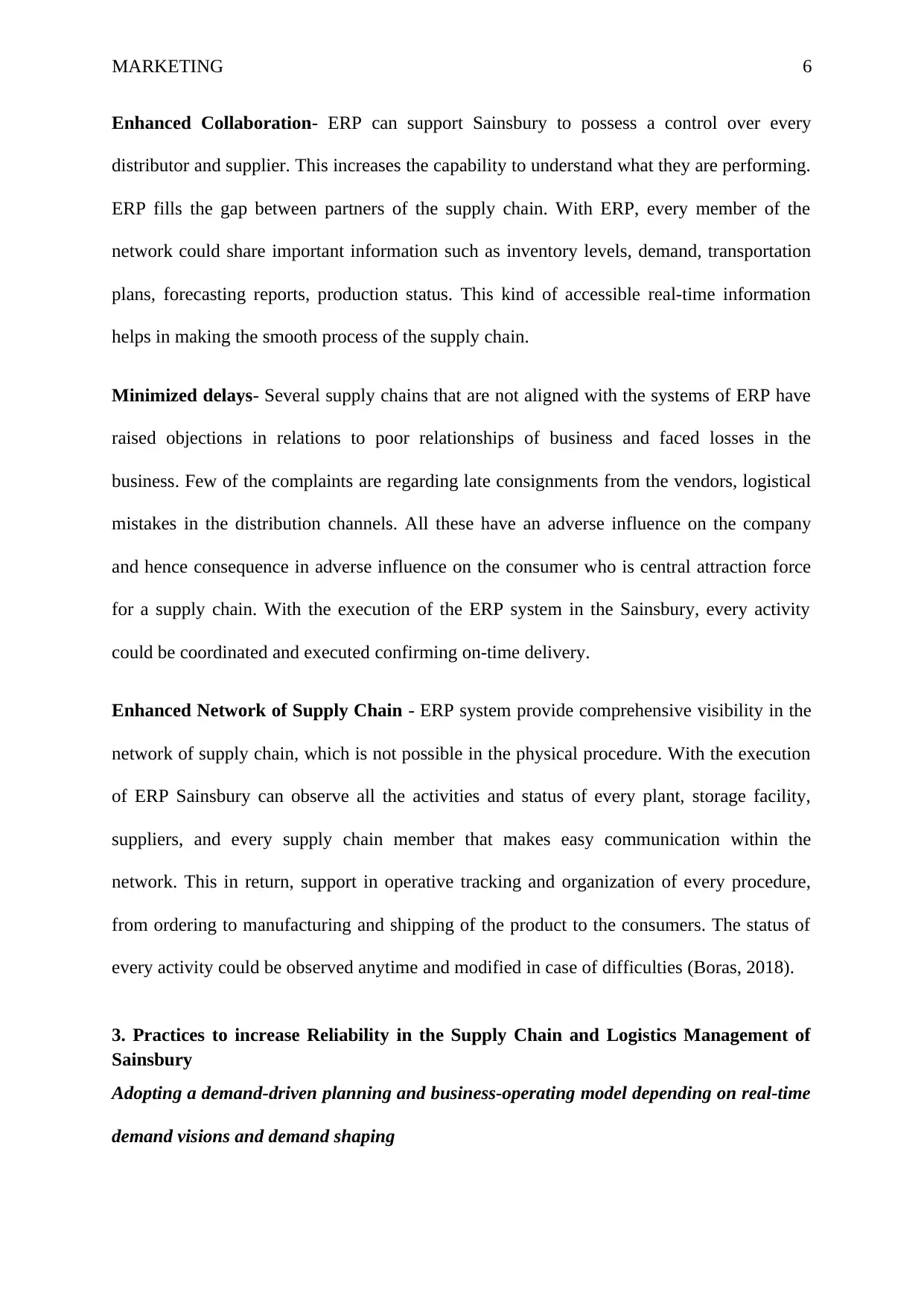
MARKETING 6
Enhanced Collaboration- ERP can support Sainsbury to possess a control over every
distributor and supplier. This increases the capability to understand what they are performing.
ERP fills the gap between partners of the supply chain. With ERP, every member of the
network could share important information such as inventory levels, demand, transportation
plans, forecasting reports, production status. This kind of accessible real-time information
helps in making the smooth process of the supply chain.
Minimized delays- Several supply chains that are not aligned with the systems of ERP have
raised objections in relations to poor relationships of business and faced losses in the
business. Few of the complaints are regarding late consignments from the vendors, logistical
mistakes in the distribution channels. All these have an adverse influence on the company
and hence consequence in adverse influence on the consumer who is central attraction force
for a supply chain. With the execution of the ERP system in the Sainsbury, every activity
could be coordinated and executed confirming on-time delivery.
Enhanced Network of Supply Chain - ERP system provide comprehensive visibility in the
network of supply chain, which is not possible in the physical procedure. With the execution
of ERP Sainsbury can observe all the activities and status of every plant, storage facility,
suppliers, and every supply chain member that makes easy communication within the
network. This in return, support in operative tracking and organization of every procedure,
from ordering to manufacturing and shipping of the product to the consumers. The status of
every activity could be observed anytime and modified in case of difficulties (Boras, 2018).
3. Practices to increase Reliability in the Supply Chain and Logistics Management of
Sainsbury
Adopting a demand-driven planning and business-operating model depending on real-time
demand visions and demand shaping
Enhanced Collaboration- ERP can support Sainsbury to possess a control over every
distributor and supplier. This increases the capability to understand what they are performing.
ERP fills the gap between partners of the supply chain. With ERP, every member of the
network could share important information such as inventory levels, demand, transportation
plans, forecasting reports, production status. This kind of accessible real-time information
helps in making the smooth process of the supply chain.
Minimized delays- Several supply chains that are not aligned with the systems of ERP have
raised objections in relations to poor relationships of business and faced losses in the
business. Few of the complaints are regarding late consignments from the vendors, logistical
mistakes in the distribution channels. All these have an adverse influence on the company
and hence consequence in adverse influence on the consumer who is central attraction force
for a supply chain. With the execution of the ERP system in the Sainsbury, every activity
could be coordinated and executed confirming on-time delivery.
Enhanced Network of Supply Chain - ERP system provide comprehensive visibility in the
network of supply chain, which is not possible in the physical procedure. With the execution
of ERP Sainsbury can observe all the activities and status of every plant, storage facility,
suppliers, and every supply chain member that makes easy communication within the
network. This in return, support in operative tracking and organization of every procedure,
from ordering to manufacturing and shipping of the product to the consumers. The status of
every activity could be observed anytime and modified in case of difficulties (Boras, 2018).
3. Practices to increase Reliability in the Supply Chain and Logistics Management of
Sainsbury
Adopting a demand-driven planning and business-operating model depending on real-time
demand visions and demand shaping
Paraphrase This Document
Need a fresh take? Get an instant paraphrase of this document with our AI Paraphraser
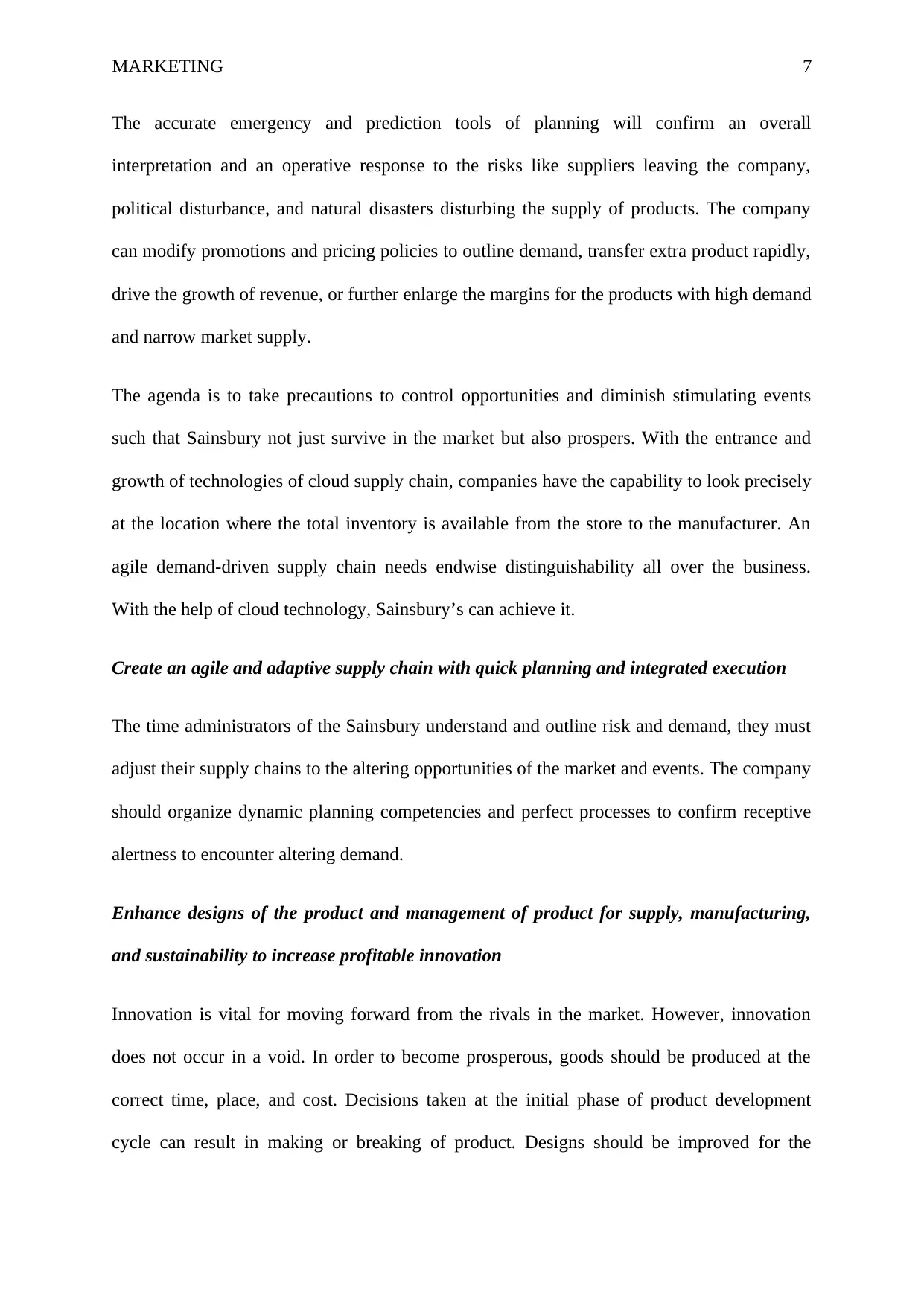
MARKETING 7
The accurate emergency and prediction tools of planning will confirm an overall
interpretation and an operative response to the risks like suppliers leaving the company,
political disturbance, and natural disasters disturbing the supply of products. The company
can modify promotions and pricing policies to outline demand, transfer extra product rapidly,
drive the growth of revenue, or further enlarge the margins for the products with high demand
and narrow market supply.
The agenda is to take precautions to control opportunities and diminish stimulating events
such that Sainsbury not just survive in the market but also prospers. With the entrance and
growth of technologies of cloud supply chain, companies have the capability to look precisely
at the location where the total inventory is available from the store to the manufacturer. An
agile demand-driven supply chain needs endwise distinguishability all over the business.
With the help of cloud technology, Sainsbury’s can achieve it.
Create an agile and adaptive supply chain with quick planning and integrated execution
The time administrators of the Sainsbury understand and outline risk and demand, they must
adjust their supply chains to the altering opportunities of the market and events. The company
should organize dynamic planning competencies and perfect processes to confirm receptive
alertness to encounter altering demand.
Enhance designs of the product and management of product for supply, manufacturing,
and sustainability to increase profitable innovation
Innovation is vital for moving forward from the rivals in the market. However, innovation
does not occur in a void. In order to become prosperous, goods should be produced at the
correct time, place, and cost. Decisions taken at the initial phase of product development
cycle can result in making or breaking of product. Designs should be improved for the
The accurate emergency and prediction tools of planning will confirm an overall
interpretation and an operative response to the risks like suppliers leaving the company,
political disturbance, and natural disasters disturbing the supply of products. The company
can modify promotions and pricing policies to outline demand, transfer extra product rapidly,
drive the growth of revenue, or further enlarge the margins for the products with high demand
and narrow market supply.
The agenda is to take precautions to control opportunities and diminish stimulating events
such that Sainsbury not just survive in the market but also prospers. With the entrance and
growth of technologies of cloud supply chain, companies have the capability to look precisely
at the location where the total inventory is available from the store to the manufacturer. An
agile demand-driven supply chain needs endwise distinguishability all over the business.
With the help of cloud technology, Sainsbury’s can achieve it.
Create an agile and adaptive supply chain with quick planning and integrated execution
The time administrators of the Sainsbury understand and outline risk and demand, they must
adjust their supply chains to the altering opportunities of the market and events. The company
should organize dynamic planning competencies and perfect processes to confirm receptive
alertness to encounter altering demand.
Enhance designs of the product and management of product for supply, manufacturing,
and sustainability to increase profitable innovation
Innovation is vital for moving forward from the rivals in the market. However, innovation
does not occur in a void. In order to become prosperous, goods should be produced at the
correct time, place, and cost. Decisions taken at the initial phase of product development
cycle can result in making or breaking of product. Designs should be improved for the
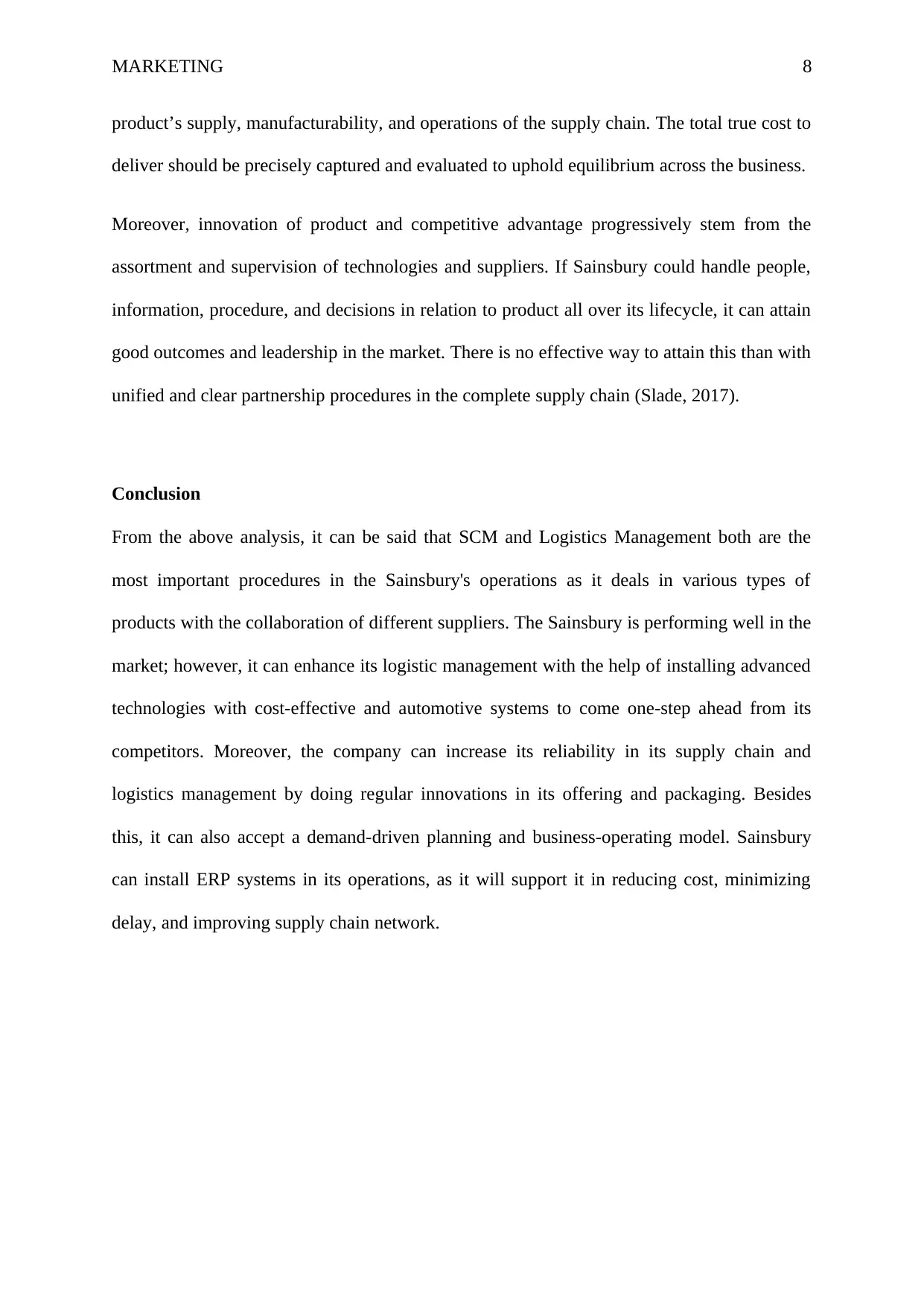
MARKETING 8
product’s supply, manufacturability, and operations of the supply chain. The total true cost to
deliver should be precisely captured and evaluated to uphold equilibrium across the business.
Moreover, innovation of product and competitive advantage progressively stem from the
assortment and supervision of technologies and suppliers. If Sainsbury could handle people,
information, procedure, and decisions in relation to product all over its lifecycle, it can attain
good outcomes and leadership in the market. There is no effective way to attain this than with
unified and clear partnership procedures in the complete supply chain (Slade, 2017).
Conclusion
From the above analysis, it can be said that SCM and Logistics Management both are the
most important procedures in the Sainsbury's operations as it deals in various types of
products with the collaboration of different suppliers. The Sainsbury is performing well in the
market; however, it can enhance its logistic management with the help of installing advanced
technologies with cost-effective and automotive systems to come one-step ahead from its
competitors. Moreover, the company can increase its reliability in its supply chain and
logistics management by doing regular innovations in its offering and packaging. Besides
this, it can also accept a demand-driven planning and business-operating model. Sainsbury
can install ERP systems in its operations, as it will support it in reducing cost, minimizing
delay, and improving supply chain network.
product’s supply, manufacturability, and operations of the supply chain. The total true cost to
deliver should be precisely captured and evaluated to uphold equilibrium across the business.
Moreover, innovation of product and competitive advantage progressively stem from the
assortment and supervision of technologies and suppliers. If Sainsbury could handle people,
information, procedure, and decisions in relation to product all over its lifecycle, it can attain
good outcomes and leadership in the market. There is no effective way to attain this than with
unified and clear partnership procedures in the complete supply chain (Slade, 2017).
Conclusion
From the above analysis, it can be said that SCM and Logistics Management both are the
most important procedures in the Sainsbury's operations as it deals in various types of
products with the collaboration of different suppliers. The Sainsbury is performing well in the
market; however, it can enhance its logistic management with the help of installing advanced
technologies with cost-effective and automotive systems to come one-step ahead from its
competitors. Moreover, the company can increase its reliability in its supply chain and
logistics management by doing regular innovations in its offering and packaging. Besides
this, it can also accept a demand-driven planning and business-operating model. Sainsbury
can install ERP systems in its operations, as it will support it in reducing cost, minimizing
delay, and improving supply chain network.
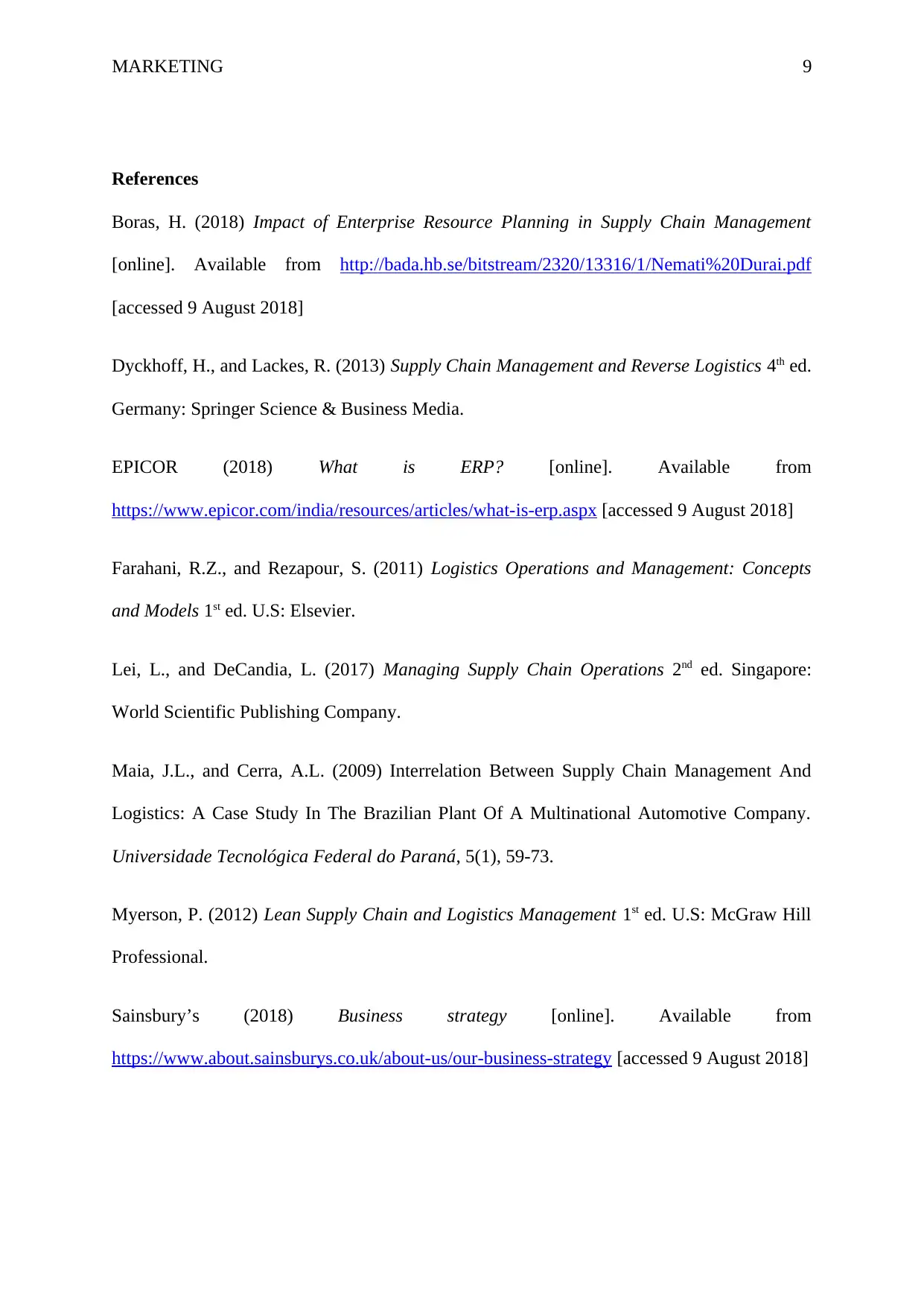
MARKETING 9
References
Boras, H. (2018) Impact of Enterprise Resource Planning in Supply Chain Management
[online]. Available from http://bada.hb.se/bitstream/2320/13316/1/Nemati%20Durai.pdf
[accessed 9 August 2018]
Dyckhoff, H., and Lackes, R. (2013) Supply Chain Management and Reverse Logistics 4th ed.
Germany: Springer Science & Business Media.
EPICOR (2018) What is ERP? [online]. Available from
https://www.epicor.com/india/resources/articles/what-is-erp.aspx [accessed 9 August 2018]
Farahani, R.Z., and Rezapour, S. (2011) Logistics Operations and Management: Concepts
and Models 1st ed. U.S: Elsevier.
Lei, L., and DeCandia, L. (2017) Managing Supply Chain Operations 2nd ed. Singapore:
World Scientific Publishing Company.
Maia, J.L., and Cerra, A.L. (2009) Interrelation Between Supply Chain Management And
Logistics: A Case Study In The Brazilian Plant Of A Multinational Automotive Company.
Universidade Tecnológica Federal do Paraná, 5(1), 59-73.
Myerson, P. (2012) Lean Supply Chain and Logistics Management 1st ed. U.S: McGraw Hill
Professional.
Sainsbury’s (2018) Business strategy [online]. Available from
https://www.about.sainsburys.co.uk/about-us/our-business-strategy [accessed 9 August 2018]
References
Boras, H. (2018) Impact of Enterprise Resource Planning in Supply Chain Management
[online]. Available from http://bada.hb.se/bitstream/2320/13316/1/Nemati%20Durai.pdf
[accessed 9 August 2018]
Dyckhoff, H., and Lackes, R. (2013) Supply Chain Management and Reverse Logistics 4th ed.
Germany: Springer Science & Business Media.
EPICOR (2018) What is ERP? [online]. Available from
https://www.epicor.com/india/resources/articles/what-is-erp.aspx [accessed 9 August 2018]
Farahani, R.Z., and Rezapour, S. (2011) Logistics Operations and Management: Concepts
and Models 1st ed. U.S: Elsevier.
Lei, L., and DeCandia, L. (2017) Managing Supply Chain Operations 2nd ed. Singapore:
World Scientific Publishing Company.
Maia, J.L., and Cerra, A.L. (2009) Interrelation Between Supply Chain Management And
Logistics: A Case Study In The Brazilian Plant Of A Multinational Automotive Company.
Universidade Tecnológica Federal do Paraná, 5(1), 59-73.
Myerson, P. (2012) Lean Supply Chain and Logistics Management 1st ed. U.S: McGraw Hill
Professional.
Sainsbury’s (2018) Business strategy [online]. Available from
https://www.about.sainsburys.co.uk/about-us/our-business-strategy [accessed 9 August 2018]
Secure Best Marks with AI Grader
Need help grading? Try our AI Grader for instant feedback on your assignments.
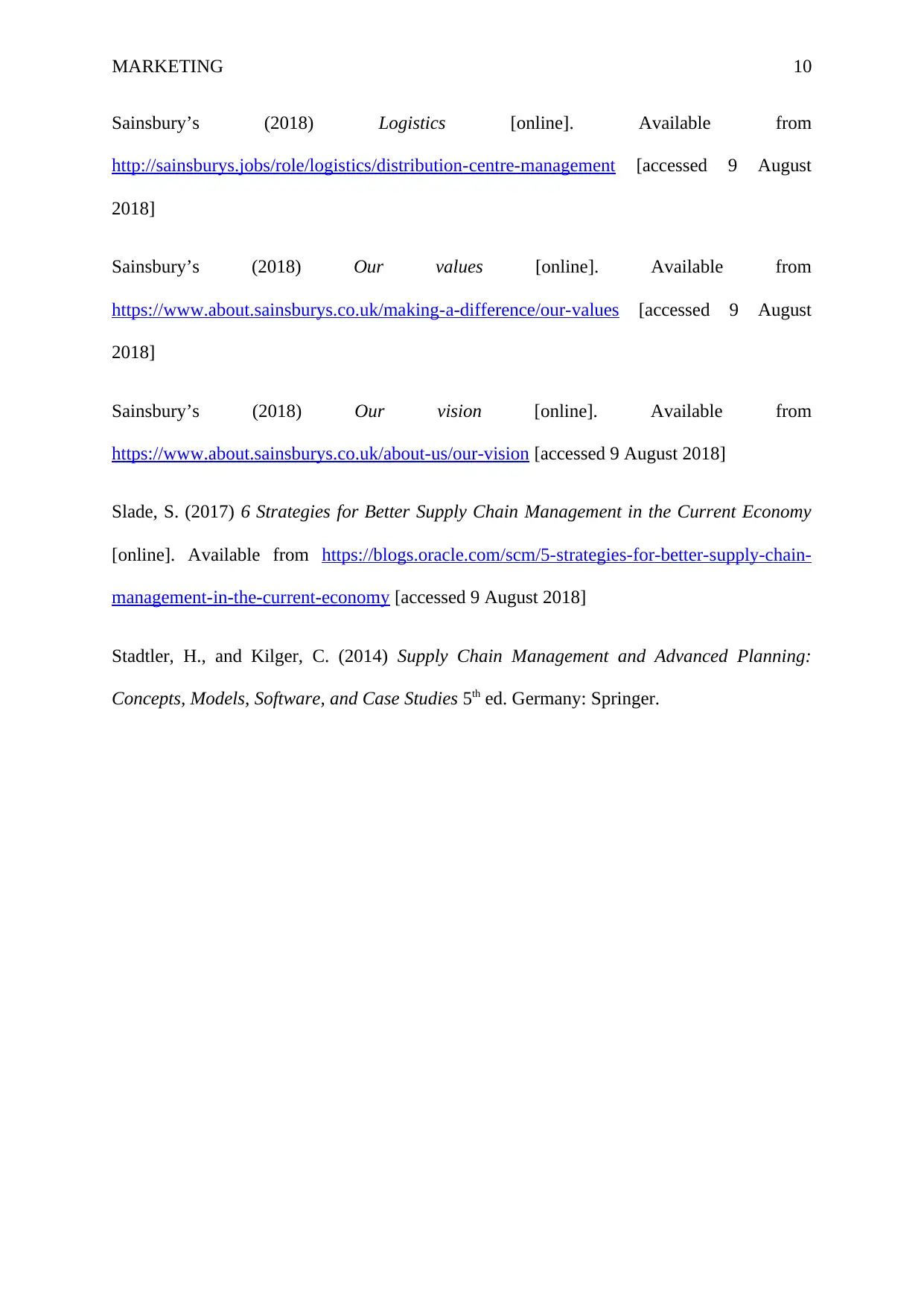
MARKETING 10
Sainsbury’s (2018) Logistics [online]. Available from
http://sainsburys.jobs/role/logistics/distribution-centre-management [accessed 9 August
2018]
Sainsbury’s (2018) Our values [online]. Available from
https://www.about.sainsburys.co.uk/making-a-difference/our-values [accessed 9 August
2018]
Sainsbury’s (2018) Our vision [online]. Available from
https://www.about.sainsburys.co.uk/about-us/our-vision [accessed 9 August 2018]
Slade, S. (2017) 6 Strategies for Better Supply Chain Management in the Current Economy
[online]. Available from https://blogs.oracle.com/scm/5-strategies-for-better-supply-chain-
management-in-the-current-economy [accessed 9 August 2018]
Stadtler, H., and Kilger, C. (2014) Supply Chain Management and Advanced Planning:
Concepts, Models, Software, and Case Studies 5th ed. Germany: Springer.
Sainsbury’s (2018) Logistics [online]. Available from
http://sainsburys.jobs/role/logistics/distribution-centre-management [accessed 9 August
2018]
Sainsbury’s (2018) Our values [online]. Available from
https://www.about.sainsburys.co.uk/making-a-difference/our-values [accessed 9 August
2018]
Sainsbury’s (2018) Our vision [online]. Available from
https://www.about.sainsburys.co.uk/about-us/our-vision [accessed 9 August 2018]
Slade, S. (2017) 6 Strategies for Better Supply Chain Management in the Current Economy
[online]. Available from https://blogs.oracle.com/scm/5-strategies-for-better-supply-chain-
management-in-the-current-economy [accessed 9 August 2018]
Stadtler, H., and Kilger, C. (2014) Supply Chain Management and Advanced Planning:
Concepts, Models, Software, and Case Studies 5th ed. Germany: Springer.
1 out of 11
Related Documents
Your All-in-One AI-Powered Toolkit for Academic Success.
+13062052269
info@desklib.com
Available 24*7 on WhatsApp / Email
![[object Object]](/_next/static/media/star-bottom.7253800d.svg)
Unlock your academic potential
© 2024 | Zucol Services PVT LTD | All rights reserved.




